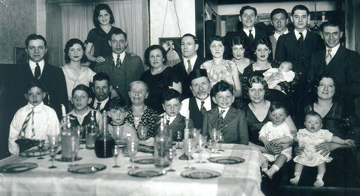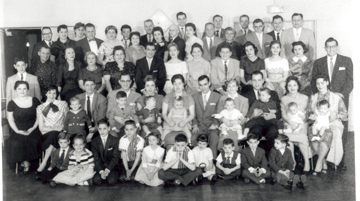Kosher-Style Comforts
Permanent link All PostsSince I left the security blanket of college about two years ago, my life has been full of change. I moved back home to the suburbs and got my first real job, and when I could no longer stand the suburbs, I moved to Lincoln Park and started a new job. I went from in a relationship, to single, to in a relationship - both in real life and on my Facebook profile. I lost touch with people I thought of as best friends, reconnected with old friends and made a lot of new ones. In what seemed like an instant, I went from child to adult, from student to professional, from carefree to neurotic. Oh, and my hair color changed from brown, to red, to somewhere in between (not to mention the horrifying gray hairs that have started popping up).

Family portrait at the seder in 1932
As someone who really doesn’t cope well with change, I look forward to those few things that remain constant in life: Chicago winters will always drag on longer than you can stand, Portillo’s chocolate cake will always make everything better and I will always spend the first night of Passover eating rubbery kosher-style food with about 80 of my closest relatives—my family’s Passover tradition.
While the cast and the characters have evolved throughout the years, the story—at least since I’ve been attending—is always the same. The service itself lasts about seven minutes tops. The youngest generation stutters and stumbles through the description of the seder plate and the four questions in Hebrew and English, Uncle Don recites the Kiddush and we’re on to the gefilte fish. Soon after, the announcement is made that “It’s time for the family update,” during which a representative from each branch of the family comes to the microphone to deliver the latest news, which ranges from remembering those who have passed to celebrating new babies and new fiancés, bu is really just an opportunity to brag. Following the meal, the kids search furiously for the afikomen hoping to claim the totally awesome prize, but I learned at a very young age that no one in my immediate family had ever found the afikomen—and apparently we never would—so eventually I just stopped looking…
As a little girl, I remember the excitement and anticipation I felt every year when I opened the envelope mailed directly to me from whichever family member was coordinating the service containing the small strip of paper revealing my part in the seder that year—although I’m not sure exactly what it was I was anticipating, since for nearly a decade I read the paragraph about the roasted shank bone, the same part my mother read before me and my sister would read after me. I remember practicing that part over and over again, because there was always a certain amount of pressure and expectation. “Don’t mumble,” my mom would always say just before it was my turn. “And stand up straight.”

Family portrait at the seder in 1957
This did not really change as I got older, but rather the expectations changed. First, I graduated to reading one of the Four Questions, and then I become the target of 20 questions, mostly focused on the nice, Jewish (God willing) boy, who may or may not be sitting next to me.
Of course over the years the seder has gone through some changes. The tradition, which originated many generations back, fizzled out after the original members passed away and was picked up again by my Grandpa Earl’s generation, involves my entire extended family on my mom’s side—aunts, uncles, cousins, second cousins, fifth cousins, you name it—all coming together in one place, once a year. The location, which began at a hotel in West Rogers Park, then moved on to Pioneer Court, a banquet hall by the old Sun Times building, now has moved to restaurants or country clubs in the suburbs as the family moved father and father north. It is always held at larger venues, because at its peak, the seder table was filled with 120 or so family members. But as people passed away, went off to college, married into other families and created traditions of their own, or simply became less observant, the numbers inevitably began to dwindle.
I always find myself looking forward to that first seder. For many of us sitting around the table, this is the only time we will see each other all year, and we can hardly recognize our cousins as they grow and change from year to year. Yet we all continue to make a special effort to spend this night together Passover after Passover. Maybe it’s because, in a time when so many people no longer celebrate their traditions, it’s nice to share that connection to Judaism and to a large family, even if its short-lived.
I know that as the years go by, as much as I try to resist it my life will continue to be filled with change and uncertainty. But I hope that I can always count on the fact that, when the time comes, my child will timidly make his or her way to the microphone to read about the roasted shank bone, search unsuccessfully for the afikomen and the tradition of our not-so-traditional seder will continue on with the next generation.



.jpg)



